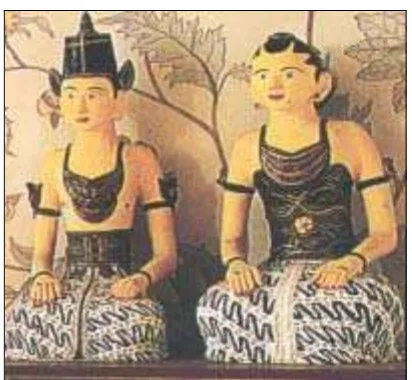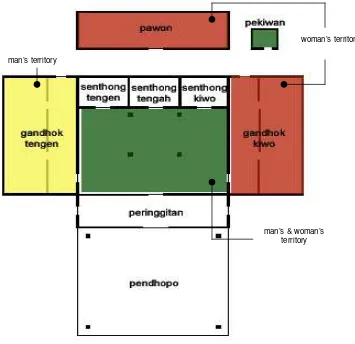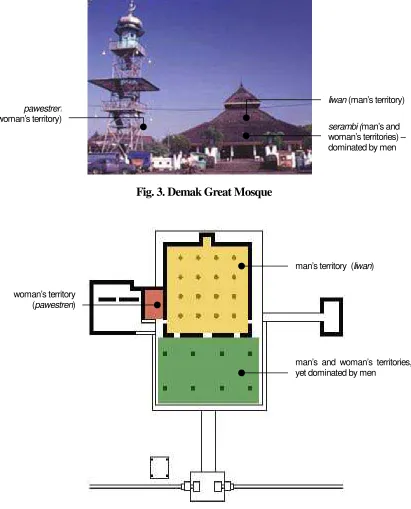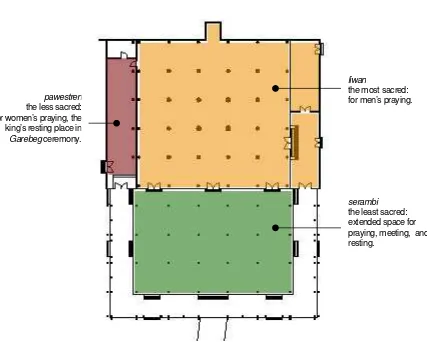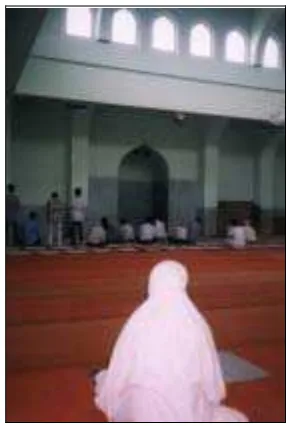THE CENTER vs. THE PERIPHERY IN CENTRAL- JAVANESE MOSQUE
ARCHITECTURE
Tutin Aryanti
Lecturer of Departement of Architecture, Indonesia University of Education e-mail: [email protected]
ABSTRACT
The existence of pawestren, women’s room in Javanese mosques, is an opportunity to promote gender equality in Muslim society. Pawestren opens women’s access to public space in Muslim society, yet still unequal to men’s. Architecturally, pawestren occupies lower hierarchy than men’s space in the mosque. The difference is also reflected in the local linguistic terms used for both spaces. In fact, pawestren, in both traditional and modern Central-Javanese mosques is considered to be an annex. This inevitably differs the access and control of women’s from men’s to the mosque. This paper aims at criticizing gender-based segregation of space in the mosque, particularly those in Central Java. Pawestren can be either good or bad potential in Islamic society beyond gender equality. This paper is expected to give insight understanding of gender equality through space and furthermore enhance the gender equality itself in religious buildings.
Keywords: gender and space, Javanese mosque architecture.
INTRODUCTION
Throughout time and across cultures, architec-ture and spatial arrangements have reinforced status differences between women and men. Women and men are spatially segregated in ways that reduce women’s access to knowledge and thereby reinforce women’s lower status relative to men’s. Daphne Spain (1992) contributed a precious basic literature on gendered spaces. She demonstrated the pervasiveness of spatial institutions and their association with gender stratification over time and across cultures by presenting a wide range of examples. Shirley Ardener (in Rendell, et.al. eds, 2000) underlined Spain’s conclusion that the spaces differing men and women are allocated culturally and the particular spaces play role in symbolizing, maintaining, and reinforcing gender relationship.
The seclusion of women from public space and public activity has proven to be significant to the subordination of women in the society. Women have limited access to knowledge, power, and economic resources. Akel Ismail Kahira “Deconstructing the American Mosque: Space, Gender, and Aesthetics” (2002) criticized space, gender, and aesthetics of American mosques. In terms of gender, he gave initial description of how gender relationship in the mosque make the contemporary expression on the buildings in North America. He found the limits of male control and female subordination, especially with regard to the rights of worship.
It is a big question why women are generally subordinated in most Muslim countries while on the contrary; Islam encourages gender equality in the society. The involvement of local norms inevitably
exists in this problem. Looking at the emergence of women’s space in Central-Javanese mosques physically and non-physically, this paper argues that traditional Javanese norms become the main aspect which influences the characteristic of the space. The existence of the specific space in public realm is an opportunity which should be explored deeper and deeper in order to accommodate the real gender equality in the society.
Using the case of Javanese mosques, this paper concerns with gender relationship in Muslim built environment, which is symbolized both physically and non-physically in the mosques. It aims to criticize gender-based segregation of space in the mosque, particularly those in Central Java, Indonesia.
GENDER AND SPATIAL SEGREGATION IN ISLAM
The resources which can be used as references in discussing Islamic perspective on gender and the position of women and men in Islam are Quran and Hadith. Both of them are the main references for Muslim all over the world. Quran is the God’s revela-tion which is then supported by Hadith containing Prophet Muhammad’s verbal and nonverbal interpre-tation on Quran.
Moreover, The Qur'an assigns commands and prohibitions to both genders, which sets the tone for the status of women.
As for social rights, Islam has always recognized the substantial role women play in society. The right of inheritance and the right of individual independent ownership unhampered by father, husband, brother, son or anyone else for that matter, has also been granted. They are given the freedom to pursue any profession including political stations.
The gender segregation of space in Islam is often interpreted as a confinement for women to get the same information in the mosque. As we refer to the Hadith of Muslim about women’s chance to go to the mosque, Prophet Muhammad did not restrict women to come to public facility1. Women used to attend the jama`ah or congregational Prayers and the Friday Prayers in the Prophet's Mosque. The Prophet urged them to stand in the last rows behind men. At the beginning, men and women used to enter through the same door. When this caused overcrowding on entrances and exits, the Prophet said, "(It would be better) if this door is left for women." Upon hearing so, the men made that door for women, and it became known up until today as "The Women's Door".
Moreover, women, at the time of the Prophet, used to attend the Friday Prayers; they used to perform the Prayer regularly and listen to the khutbah (= preach; Arabic) to the extent that one of them could recite Surat Qaf as she heard the Prophet recite it several times in the Friday khutbah. Women also used to attend the Eid Prayers and participate in that big Islamic festival that included the old and the young, men as well as women, out in the open, all worshipping Allah.
Umm Attiyyah narrated, "We used to be ordered to come out on the Day of the Eid and even bring out the virgin girls from their houses and menstruating women so that they might stand behind the men and say takbir along with them and invoke Allah along with them and hope for the blessings of that day and for purification from sins" (Reported by Al-Bukhari). Women also used to attend religious sermons with men at the Prophet's house and they used to inquire about religious matters that many women nowadays would find embarrassing to ask about. For instance, Aishah (the Prophet’s wife) praised the women of Al-Ansar for trying to understand their religion without being held back by bashfulness for they used to ask about such matters as major ritual impurity, wet dream, purificatory bath, menstruation, etc. When women found that men's questions were taking most
1
http://www.youngmuslims.ca/ymfn/archive_display.asp?ID=264
of the Prophet's time, they plainly requested the Prophet to make a special day for women. So the Prophet dedicated a day for them when he used to give them lessons and sermons (Narrated by Al-Bukhari). Abdullah bin Umar said that Prophet Muhammad stated, "Do not prevent your women from going to the mosque, although their homes are better for them (for their prayers)" (Narated by Abu Daud). Thus, it is clear that Islam does not forbid women to be in the public space, particularly in the mosque.
The traditions in Muslim societies generally discourage and limit women’s access to public space and public activity. In several Muslim communities, the concept of hijab (spatial segregation) which specifically applied as purdah (keeping from public view) refers to the veiling and seclusion of Muslim women to minimize their contact with men (Caplan, 1985; Mandelbaum, 1988; Papanek, 1973 in Spain, 1992). Segregation from men is the cornerstone of purdah and most Muslim believe that purdah is divinely ordained. Based on the same norm, Muslim women cannot enter the male sanctum of the mosque; on the contrary they must pray at home (Mandelbaum, 1988 in Spain, 1992). A dilemma that tends to weigh against the consistent use of a functional norm or spatial ideal is the understanding of space and gender in Islam. The ways in which Muslim society have dealt with this delicate problem are sometimes distasteful, requiring that rules of some kind must exist and must be formulated as unequivocally as possible. However, in the text of the Quran, there is no such legal or religious imperative. Women have the right to go to the mosque, and the Prophet's mosque at Madinah had free access for both sexes, but this does not itself imply that the contemporary mosques are free from gender con-straints. In many traditional Muslim societies, a set of rigorous male-formulated rules restricts the use of the mosque by women.
GENDER AND SPATIAL SEGREGATION IN JAVANESE PERSPECTIVE
complement to her husband. Traditional Islamic Javanese society thought that progression and education only belonged to men who would be the leaders of their households and societies. Girls might get Islamic education in preacher’s house until the age of ten, while the rest would be their fathers’ responsibility. As Indonesia entered a new era as an independent nation, women’s position is getting better and better; even most people of Java are still thinking that women do not need good education as men do.
Fig 1. Loroblonyo representing the duality in Javanese norms
Muhammadiyah movement, which spread out all over Central Java since 1925, has changed people’s perspective about women. Muhammadiyah
tries to bring Javanese women into a better condition and put them in an equal position as men have. In the beginning of its struggle, Muhammadiyah used community mosques as a media and place to teach women and gave them gender consciousness that women had social role, besides their role in the households.
The duality is shown in the traditional Javanese house, which is spatially segregated based on local gender norms and varies on different events. The segregation can be described in the following figure 2.
PAWESTREN: AN OPPORTUNITY IN PUBLIC REALM
While mosques in most Muslim countries ban women to come and pray in the place, the mosques in Central Java have permitted women to come to the mosques since the beginning of the eighteenth century when Demak Great Mosque2 provided a particular
2
Demak Sultanate was the first Muslim sultanate in Java (founded by Raden Patah in 1401).
building for women’s praying called pawestren. It was popular for almost a century, but then Yogyakarta Great Mosque built the same facility in the left side of the mosque with a full-height dividing wall separating men’s area from women’s area. Soon, this became a trend to make the mosques opened to women.
The location of pawestren in the mosques in Central Java varies. The cultural differences between Islamic community of coastal and inland area have created different pattern of gender segregation of space between men and women in the mosques. In coastal area, pawestren is generally located in a separated space at the right side of the main praying hall (liwan) allocated for men. While in inland area, in the room, which initially occupied separated space at the left side, is now shifting to the rear side of the main praying hall (liwan). Almost all great mosques place their pawestren on the left arm of the mosque. The mosques of inland area probably take the great mosques, which belonged to local old kingdom, as their reference. Almost all old mosques in the area use the same pattern the great mosques use.
Pawestren changes in position and physical characteristics over time. Traditional mosques in rural area usually provide a particular room which is separated from the main room–occupied by men-by a full-height wall. The mosques which were construc-ted in the period of 1970s to 1990s did not use full divider at all. In other words, the mosques did not provide particular space for women in the mosques. It did not exist yet welcome women to pray in the mosques. The praying space was thus defined temporarily according to the activity and the number of its attendance.
EXAMINING PAWESTREN THROUGH GENDER PERSPECTIVE
The emergence of pawestren (praying room for women) in the mosques of Central Java, Indonesia, in the beginning of the eighteenth century marked a significant change of perception on women’s status and role in Javanese Islamic community. Indepen-dence moment of Indonesia may become a milestone of the changes in Islamic architecture in Central Java, generally in Indonesia. Mosque architecture, since 1970s has grown into a modern style, including
The existence of pawestren in the mosques at least indicates a good intention of the society to acknowledge women’s existence in the community, especially Islamic community. But it will not be so simple to judge that pawestren guarantees gender equality in the mosque. The next part of this paper will analyze how is gender relationship in the mosques of Central Java by the existence of
pawestren.
The position of pawestren in the old mosque, at least, is influenced by cultural norms held by local society. Traditional Javanese norms place woman as the second person on the left side of man. The right side, in Javanese idea, symbolizes ‘male’, maleness and powerful, which is then taking man as the protector. While left symbolize ‘female’, femaleness, weak, and thus occupied by someone who needs protection.
Local old kingdom plays an important role in this case. The great mosque built by the kingdom became a model for other community mosques especially in architectural performance and manage-ment. One can find the layout similarity between
kraton (king’s palace) and the great mosque. This
pattern is not found in the mosques of an area remote from the palace, such as north coastal area.
Center vs. Periphery
Most traditional mosques of Central Java were built without pawestren. The spaces for women were generally provided after the mosques were operated for a certain period. The spaces were thus located in the periphery of the mosques. Some rural mosques were constructed by taking the architecture of the great mosque nearby as a model, thus put the
pawestren on the side arm of the main room of the mosque. The following figure describes that
pawestren is an unplanned annex of the mosque. As an annex, pawestren is thus perceived as a second-level space in the mosque, lower than the main praying room, which is the most sacred space of the mosque. Hierarchy of space architecturally speaks of the hierarchy of activity and who does the activity within.
Fig. 2. The spatial segregation of traditional Javanese house in everyday life
woman’s territory
man’s territory
Large Space vs. Small Space
Women occupy a smaller space, even a very small one, in the mosque. It is probably considered based on a perspective that women’s attendance in the mosque is not an obligation. On the contrary, men have to attend the Prayers in the mosque, mainly the Friday Prayer.
High Level vs. Low Level
Most of Central-Javanese mosques locate
pawestren on the equal level to serambi (= verandah; Indonesian). While liwan (= the main praying room; Arabic) and pawestren are occupied for praying, the serambi itself is occupied for non-praying activities, such as chatting, meeting, resting, even sleeping.
Fig. 3. Demak Great Mosque
liwan (man’s territory)
serambi (man’s and woman’s territories) – dominated by men
pawestren
(woman’s territory)
Fig. 4. The spatial segregation in Demak Great Mosque, Central Java
man’s and woman’s territories, yet dominated by men
man’s territory (liwan)
“The Inside” vs. “the Outside”
There is a discrimination in local linguistic terms used for both spaces. The term “ngelebet” (= inside; Javanese) is used to refer liwan. Some non-praying activities, such as sleeping and resting, are forbidden to be done in liwan; on the contrary, they are allowed in pawestren and serambi. In Yogyakarta Great
Mosque, pawestren is used annually as the king’s place to rest in Garebeg ceremony. The king and his family usually eat some fruits in the pawestren after a long march of Garebeg routed from the kraton
(king’s palace) to Alun-alun (city square) and end up at the great mosque.
Fig. 5. The section of Yogyakarta Great Mosque
pawestrenwoman’s territory
Liwan man’s territory
side serambi
man’s territory
Fig. 6. The plan of Yogyakarta Great Mosque
serambi
the least sacred: extended space for praying, meeting, and resting.
liwan
the most sacred: for men’s praying.
pawestren
the less sacred: for women’s praying, the king’s resting place in
CLOSING NOTES: PAWESTREN AND PSEUDO-GENDER EQUALITY
Cultural diffusion between Islam and Javanese culture seems to be a positive aspect in the entering process of Islam to Javanese society. Unfortunately, the effects of the diffusion sacrifice Islamic principles. In the case of pawestren, women’s position in the mosque is blurred and finally does not solve women’s problem in gender relationship, what is more makes it worse.
Fig. 7. Pawestren is located on the balcony of the mosque
Since 1970s, as the Indonesian and local governments started to support Islamic activities, mosque architects began to alter many ways in solving the problems in previous position of
pawestren. They introduced a balcony type of
pawestren considering the best solution, which allows women privacy and avoids direct contact between men and women without subordinating women in peripheral.
The position of pawestren shows us that women’s participation in mosques is still one rare policy. People opinion about the belonging of the mosque mainly to men is a wrong condition and thus harmful to women. It is then a new dilemma that
pawestren as a certain space with physical borders will give women a certain place in the mosque but on the other hand, it bounds women’s interaction and access with men. While pawestren as a temporary space in the main praying room may give wider access to women but also threaten their existence in the mosque because of the absent of the certain space.
Pawestren as gender segregation of space is a good potential in Islamic society beyond gender equality. Architecture and architect with their technology and knowledge should be the supporter to gain the ideal condition and spatially gives
consciousness to the society. We cannot put the stakeholders aside, too, since almost all mosques in Central Java are dominated by certain persons as society leaders and convictions. Thus we can expect more to pawestren to raise women’s existence in the mosque as a community center and in the society itself.
Fig. 8. The absence of pawestren: threating or encouraging gender equality?
REFERENCES
Al-Jamal, Ibrahim Muhammad, Fiqih Wanita. Sema-rang: CV. Asy Syifa’. 1981.
Al-Qaradhawi, Yusuf, Tuntunan Membangun Masjid. Jakarta: Gema Insani Press. 2000.
Aryanti, Tutin, “Segregasi Ruang Masjid menurut Jender: Fenomena Munculnya Pawestren pada Masjid-Masjid di Jawa Tengah” Bandung: Master thesis, Architecture, Institut Teknologi Bandung. 2000.
Atmadi, Parmono and Ismudiyanto, Demak, Kudus, and Jepara Mosque : A Study of Architectural Syncretism. Yogyakarta: Gajah Mada Univer-sity. 1987.
Baidan, Nashruddin, Tafsir bi Al-Ra’yi, Upaya Peng-galian Konsep Wanita dalam Al Qur’an. Yogyakarta: Pustaka Pelajar. 1999
Geertz, Clifford, Abangan, Santri, Priyayi Dalam Masyarakat Jawa. Jakarta: PT. Dunia Pustaka Jaya. 1981.
Idris, Irzaidi, “Pengaruh Kosmologi Hindu-Budha pada Masjid Awal di Jawa” Bandung: Master
thesis, Architecture, Institut Teknologi Ban-dung. 1994.
Ismail, Akel Kahira, Deconstructing the American Mosque: Space, Gender, and Aesthetics.
Austin: University of Texas Press. 2002.
Izzat, Hibbah Rauf, Wanita dan Politik Pandangan Islam. Bandung: PT Remaja Rosdakarya. 1997.
Kühnel, Ernst, Islamic Art and Architecture. New York: Cornell University Press. 1966.
Lombard, Denys, Nusa Jawa: Silang Budaya, Bagian II: Jaringan Asia. Jakarta: PT Gramedia Pustaka Utama. 1996.
Magnis-Suseno, Franz, Etika Jawa, Sebuah Analisa Falsafi tentang Kebijaksanaan Hidup Jawa. Jakarta: PT. Gramedia Pustaka Utama. 1984.
Mahmudah, Konsep Wanita Karir Menurut Pan-dangan Etika Jawa Yogyakarta: Fakultas Filsafat Universitas Gajah Mada. 1997.
Matrix, Making Space – Women and The Man-made Environment. London: Pluto Press Limited. 1984.
Michell, George (ed), Architecture of The Islamic World, Its History and Social Meaning. London: Thames and Hudson Ltd. 1978.
Moedjanto, G, Konsep Kekuasaan Jawa, Penerapan-nya Oleh Raja-Raja Mataram. Yogyakarta: Penerbit Kanisius. 1987.
Muqoffa, M., “Aspek Jender pada Dalem Bangsawan Di Surakarta” Bandung: Master thesis, Archi-tecture, Institut Teknologi Bandung.1998.
Murata, Sachiko, The Tao of Islam, Kitab Rujukan tentang Relasi Gender dalam Kosmologi dan Teologi Islam. Bandung: Mizan. 1996.
Rapoport, Amos, House Form and Culture. New Jersey: Prentice-Hall, Inc. 1969.
——— (ed), The Mutual Interaction of People and Their Built Environment, A Cross Culture Perspective. Paris: Mouton Publishers. 1976.
Robinson, Francis, Atlas of The Islamic World Since 1500. Oxford: Phaidon Press Ltd. 1982.
Soeratman, Darsiti, Kehidupan Dunia Kraton Sura-karta 1830 – 1939. Yogyakarta: Penerbit Tamansiswa. 1989.
Spain, Daphne, Gendered Spaces. Chapel Hill and London: The University of North California Press. 1992.
Supriyadi, Bambang, “Studi Perkembangan Morfo-logi Bangunan Masjid di Pesisir Wetan Pantai Utara Jawa Tengah” Bandung: Master thesis, Architecture, Institut Teknologi Bandung. 1991.
Suryochondro, Sukanti, Potret Pergerakan Wanita di Indonesia. Jakarta: Penerbit CV. Rajawali. 1984.
Susanto, Budi and Praptodiharja, Sudiarja (eds), Citra Wanita dalam Kekuasaan (Jawa). Yogya-karta: Penerbit Kanisius. 1992.
Umar, Nasaruddin, Argumen Kesetaraan Jender, Perspektif Al-Quran. Jakarta: Penerbit Parama-dina. 1999.
van Bruinessen, Martin, NU, Tradisi, Relasi-Relasi Kuasa, Pencarian Wacana Baru. Yogyakarta: LkiS. 1994.
Wajcman, Judy, Feminism Confronts Technology
Cambridge: Polity Press. 1991/93.
Wekerle, Gerda R (eds), New Space for Women. Colorado: Westview Press, Inc. 1980.
http://www.youngmuslims.ca/ymfn/archive_display.a sp?ID=264
